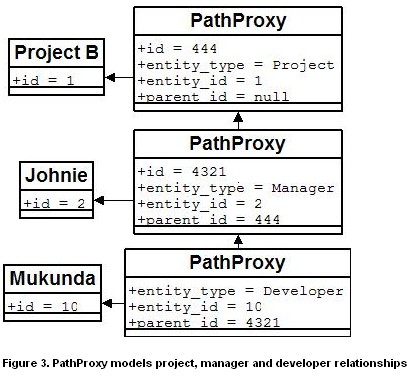иҷҪ然ҫ|‘дёҠе•Ҷеә—еҪўејҸеӨҡж ·,жҜҸдёӘз«ҷзӮ№жңүиҮӘе·Юqҡ„зү№иүІ,дҪҶд№ҹжңүе…¶дёҖиҲ¬зҡ„е…ұжҖ?еҚ•е°ұ"е•Ҷе“Ғзҡ„еҸҳеҢ?д»ҘдҫҝеҸҠж—¶йҖҡзҹҘи®ўжҲ·"ҳqҷдёҖзӮ?жҳҜеҫҲеӨҡзҪ‘дёҠе•Ҷеә—е…ұжңүзҡ„жЁЎејҸ,ҳqҷдёҖжЁЎејҸҫcЦMјјObserver patern.
е…·дҪ“зҡ„иҜҙ,еҰӮжһңҫ|‘дёҠе•Ҷеә—дёӯе•Ҷе“ҒеңЁеҗҚз§° д»дh јҪ{үж–№йқўжңүеҸҳеҢ–,еҰӮжһңҫpИқ»ҹиғҪиҮӘеҠЁйҖҡзҹҘдјҡе‘ҳ,һ®ҶжҳҜҫ|‘дёҠе•Ҷеә—еҢәеҲ«дј з»ҹе•Ҷеә—зҡ„дёҖеӨ§зү№иү?ҳqҷе°ұйңҖиҰҒеңЁе•Ҷе“ҒproductдёӯеҠ е…ҘObserverҳqҷж ·и§’иүІ,д»ҘдҫҝproductҫlҶиҠӮеҸ‘з”ҹеҸҳеҢ–ж—?ObserverиғҪиҮӘеҠЁи§ӮеҜҹеҲ°ҳqҷз§ҚеҸҳеҢ–,тq¶иғҪҳqӣиЎҢеҸҠж—¶зҡ„updateжҲ–notifyеҠЁдҪң.

Javaзҡ„APIҳqҳдШ“дёәжҲ‘们жҸҗдҫӣзҺ°жҲҗзҡ„ObserverжҺҘеҸЈJava.util.Observer.жҲ‘们еҸӘиҰҒзӣҙжҺҘдҪҝз”Ёе®ғе°ұеҸҜд»Ҙ.
жҲ‘们еҝ…йЎ»extends Java.util.ObserverжүҚиғҪзңҹжӯЈдҪҝз”Ёе®?
1.жҸҗдҫӣAdd/Delete observerзҡ„ж–№жі?
2.жҸҗдҫӣйҖҡзҹҘ(notisfy) жүҖжңүobserverзҡ„ж–№жі?
|
//дә§е“Ғҫc?еҸҜдҫӣJspзӣҙжҺҘдҪҝз”ЁUseBeanи°ғз”Ё иҜҘзұ»дё»иҰҒжү§иЎҢдә§е“Ғж•°жҚ®еә“жҸ’е…?жӣҙж–° гҖҖгҖҖprivate String name; гҖҖгҖҖpublic String getName(){ return name;} гҖҖгҖҖ}гҖҖгҖҖгҖҖ гҖҖгҖҖpublic float getPrice(){ return price;} гҖҖгҖҖ}
} |
жҲ‘们注ж„ҸеҲ?еңЁproductҫcЦMёӯ зҡ„setXXXж–ТҺі•дё?жҲ‘们讄ЎҪ®дә?notify(йҖҡзҹҘ)ж–ТҺі•, еҪ“JspиЎЁеҚ•и°ғз”ЁsetXXX(еҰӮдҪ•и°ғз”Ёи§ҒжҲ‘зҡ?a target="_blank">еҸҰеӨ–дёҖҪӢҮж–Үз«?/font>),е®һйҷ…дёҠе°ұи§ҰеҸ‘дәҶnotisfyObserversж–ТҺі•,ҳqҷе°ҶйҖҡзҹҘзӣёеә”и§ӮеҜҹиҖ…еә”иҜҘйҮҮеҸ–иЎҢеҠЁдәҶ.
дёӢйқўзңӢзңӢҳqҷдәӣи§ӮеҜҹиҖ…зҡ„д»Јз Ғ,他们ҪI¶з«ҹйҮҮеҸ–дәҶд»Җд№ҲиЎҢеҠ?
|
//и§ӮеҜҹиҖ…NameObserverдё»иҰҒз”ЁжқҘеҜ№дс”е“ҒеҗҚҝU?name)ҳqӣиЎҢи§ӮеҜҹзҡ?br />public class NameObserver implements Observer{ гҖҖгҖҖprivate String name=null; гҖҖгҖҖpublic void update(Observable obj,Object arg){ гҖҖгҖҖгҖҖгҖҖ name=(String)arg; гҖҖгҖҖгҖҖгҖҖ} гҖҖгҖҖ}
}
//и§ӮеҜҹиҖ…PriceObserverдё»иҰҒз”ЁжқҘеҜ№дс”е“Ғдӯhж ?price)ҳqӣиЎҢи§ӮеҜҹзҡ?br />public class PriceObserver implements Observer{ гҖҖгҖҖprivate float price=0; гҖҖгҖҖpublic void update(Observable obj,Object arg){ гҖҖгҖҖгҖҖгҖҖ price=((Float)arg).floatValue(); гҖҖгҖҖгҖҖгҖҖ} гҖҖгҖҖ}
} |
JspдёӯжҲ‘们еҸҜд»ҘжқҘжӯЈејҸжү§иЎҢҳqҷж®өи§ӮеҜҹиҖ…зЁӢеә?
|
<jsp:useBean id="product" scope="session" class="Product" />
<jsp:useBean id="nameobs" scope="session" class="NameObserver" />
<jsp:useBean id="priceobs" scope="session" class="PriceObserver" />
<%
}else{
%> гҖҖгҖҖ//request.getRequestURI()жҳҜдс”з”ҹжң¬jspзҡ„зЁӢеәҸеҗҚ,һ®ұжҳҜиҮӘе·ұи°ғз”ЁиҮӘе·ұ гҖҖгҖҖ<input type=hidden name="save" value="1"> гҖҖгҖҖ</form>
<%
%>
В
В
В |
жү§иЎҢж”?span lang="EN-US">JspҪEӢеәҸ,дјҡеҮәзҺоCёҖдёӘиЎЁеҚ•еҪ•е…Ҙз•Ңйқ? йңҖиҰҒиҫ“е…Ҙдс”е“ҒеҗҚҝU?дә§е“Ғд»дh ј, зӮТҺҢүSubmitеҗ?ҳqҳжҳҜжү§иЎҢиҜҘjspзҡ?br />if (request.getParameter("save")!=null)д№Ӣй—ҙзҡ„д»Јз ?
з”ЧғәҺҳqҷйҮҢдҪҝз”ЁдәҶж•°жҚ®javabeansзҡ„иҮӘеҠЁиөӢеҖјжҰӮеҝ?е®һйҷ…ҪEӢеәҸиҮӘеҠЁжү§иЎҢдәҶsetName setPriceиҜӯеҸҘ.дҪ дјҡеңЁжңҚеҠЎеҷЁжҺ§еҲ¶еҸоCёӯеҸ‘зҺ°дёӢйқўдҝЎжҒҜ::
NameObserver :name changet to ?????(JspиЎЁеҚ•дёӯиҫ“е…Ҙзҡ„дә§е“ҒеҗҚз§°)
PriceObserver :price changet to ???(JspиЎЁеҚ•дёӯиҫ“е…Ҙзҡ„дә§е“Ғд»дh ј);
ҳqҷиҜҙжҳҺи§ӮеҜҹиҖ…е·ІҫlҸеңЁиЎҢеҠЁдә?span lang="EN-US">.!!
еҗҢж—¶дҪ дјҡеңЁжү§иЎҢjspзҡ„жөҸи§ҲеҷЁз«Ҝеҫ—еҲоCҝЎжҒ?
дә§е“Ғж•°жҚ®еҸҳеҠЁ дҝқеӯҳ! тq¶е·ІҫlҸиҮӘеҠЁйҖҡзҹҘе®ўжҲ·
дёҠж–Үз”ЧғәҺдҪҝз”ЁjspжҰӮеҝө,йҡҗеҗ«еҫҲеӨҡиҮӘеҠЁеҠЁдҪң,зҺ°е°Ҷи°ғз”Ёи§ӮеҜҹиҖ…зҡ„Javaд»Јз ҒеҶҷеҰӮдё?
|
В
public class Test { гҖҖгҖҖpublic static void main(String args[]){
Product product=new Product();
//еҠ е…Ҙи§ӮеҜҹиҖ?br />product.addObserver(nameobs);
product.setName("ҠҷҳеӯҗҫUўдәҶ"); гҖҖгҖҖ}
}
В
В
В |
дҪ дјҡеңЁеҸ‘зҺоCёӢйқўдҝЎжҒ?span lang="EN-US">::
NameObserver :name changet to ҠҷҳеӯҗҫUўдәҶ
PriceObserver :price changet to 9.22
ҳqҷиҜҙжҳҺи§ӮеҜҹиҖ…еңЁиЎҢеҠЁдә?span lang="EN-US">.!!
жқҘжәҗ еQ?http://book.javanb.com/java-design-patterns/Observer.html
һ®ҶеҜ№иұЎд»Ҙж ‘еЕһҫl“жһ„ҫl„з»ҮиөдhқҘ,д»ҘиҫҫжҲҗвҖңйғЁеҲҶпјҚж•ҙдҪ“вҖ?зҡ„еұӮӢЖЎз»“жһ„пјҢдҪҝеҫ—е®ўжҲ·з«ҜеҜ№еҚ•дёӘеҜ№иұЎе’Ңз»„еҗҲеҜ№иұЎзҡ„дҪҝз”Ёе…дhңүдёҖиҮҙжҖ?
CompositeжҜ”иҫғе®ТҺҳ“зҗҶи§ЈеQҢжғіеҲ°Compositeһ®ұеә”иҜҘжғіеҲ°ж ‘еҪўз»“жһ„еӣҫгҖӮз»„еҗҲдҪ“еҶ…иҝҷдәӣеҜ№иұЎйғҪжңүе…ұеҗҢжҺҘеҸ?еҪ“з»„еҗҲдҪ“дёҖдёӘеҜ№иұЎзҡ„ж–ТҺі•иў«и°ғз”Ёжү§иЎҢж—¶еQҢCompositeһ®ҶйҒҚеҺ?Iterator)ж•ҙдёӘж ‘еЕһҫl“жһ„,еҜАLүҫеҗҢж ·еҢ…еҗ«ҳqҷдёӘж–ТҺі•зҡ„еҜ№иұЎеЖҲе®һзҺ°и°ғз”Ёжү§иЎҢгҖӮеҸҜд»Ҙз”ЁзүөдёҖеҠЁзҷҫжқҘеЕһе®ҸVҖ?o:p>
жүҖд»?span lang="EN-US">CompositeжЁЎејҸдҪҝз”ЁеҲ°IteratorжЁЎејҸеQҢе’ҢChain of ResponsibilityжЁЎејҸҫcЦMјјгҖ?o:p>
CompositeеҘҪеӨ„
:
1.дҪҝе®ўжҲпL«Ҝи°ғз”ЁҪҺҖеҚ•пјҢе®ўжҲ·з«ҜеҸҜд»ҘдёҖиҮҙзҡ„дҪҝз”Ёҫl„еҗҲҫl“жһ„жҲ–е…¶дёӯеҚ•дёӘеҜ№иұЎпјҢз”ЁжҲ·һ®ЧғёҚеҝ…е…іҫp»иҮӘе·ұеӨ„зҗҶзҡ„жҳҜеҚ•дёӘеҜ№иұЎиҝҳжҳҜж•ҙдёӘз»„еҗҲз»“жһ„пјҢҳqҷе°ұҪҺҖеҢ–дәҶе®ўжҲ·з«Ҝд»Јз ҒгҖ?br />2.жӣҙе®№жҳ“еңЁҫl„еҗҲдҪ“еҶ…еҠ е…ҘеҜ№иұЎйғЁдҡg. е®ўжҲ·з«ҜдёҚеҝ…еӣ дёәеҠ е…ҘдәҶж–°зҡ„еҜ№иұЎйғЁдҡgиҖҢжӣҙж”№д»Јз ҒгҖ?o:p>
еҰӮдҪ•дҪҝз”ЁComposite?
йҰ–е…Ҳе®ҡд№үдёҖдёӘжҺҘеҸЈжҲ–жҠҪиұЎҫc»пјҢҳqҷжҳҜи®ҫи®ЎжЁЎејҸйҖҡз”Ёж–№ејҸдәҶпјҢе…¶д»–и®ҫи®ЎжЁЎејҸеҜТҺҺҘеҸЈеҶ…йғЁе®ҡд№үйҷҗеҲ¶дёҚеӨҡпјҢCompositeеҚҙжңүдёӘ规е®ҡпјҢйӮЈе°ұжҳҜиҰҒеңЁжҺҘеҸЈеҶ…йғЁе®ҡд№үдёҖдёӘз”ЁдәҺи®ҝй—®е’ҢҪҺЎзҗҶCompositeҫl„еҗҲдҪ“зҡ„еҜ№иұЎд»¬пјҲжҲ–з§°йғЁдҡgComponentеQ?
дёӢйқўзҡ„д»Јз ҒжҳҜд»ҘжҠҪиұЎзұ»е®ҡд№үеQҢдёҖиҲ¬е°ҪйҮҸз”ЁжҺҘеҸЈinterface,
|
public abstract class Equipment |
жҠҪиұЎҫc?span lang="EN-US">Equipmentһ®ұжҳҜComponentе®ҡд№үеQҢд»ЈиЎЁзқҖҫl„еҗҲдҪ“зұ»зҡ„еҜ№иұЎд»¬,Equipmentдёӯе®ҡд№үеҮ дёӘе…ұеҗҢзҡ„ж–ТҺі•гҖ?o:p>
|
public class Disk extends Equipment |
DiskжҳҜз»„еҗҲдҪ“еҶ…зҡ„дёҖдёӘеҜ№иұЎпјҢжҲ–з§°дёҖдёӘйғЁд»УһјҢҳqҷдёӘйғЁдҡgжҳҜдёӘеҚ•зӢ¬е…ғзҙ ( Primitive)гҖ?br />ҳqҳжңүдёҖҝUҚеҸҜиғҪжҳҜеQҢдёҖдёӘйғЁд»¶д№ҹжҳҜдёҖдёӘз»„еҗҲдҪ“еQҢе°ұжҳҜиҜҙҳqҷдёӘйғЁдҡgдёӢйқўҳqҳжңү'е„ҝеӯҗ'еQҢиҝҷжҳҜж ‘еҪўз»“жһ„дёӯйҖҡеёёзҡ„жғ…еҶөпјҢеә”иҜҘжҜ”иҫғе®ТҺҳ“зҗҶи§ЈгҖӮзҺ°еңЁжҲ‘们е…ҲиҰҒе®ҡд№үиҝҷдёӘз»„еҗҲдҪ“еQ?o:p>
|
abstract class CompositeEquipment extends Equipment гҖҖгҖҖ//жіЁж„ҸҳqҷйҮҢеQҢиҝҷйҮҢе°ұжҸҗдҫӣз”ЁдәҺи®үK—®иҮӘе·ұҫl„еҗҲдҪ“еҶ…зҡ„йғЁд»¶ж–№жі•гҖ?br />гҖҖгҖҖ//дёҠйқўdIsk д№ӢжүҖд»ҘжІЎжңүпјҢжҳҜеӣ дёәDiskжҳҜдёӘеҚ•зӢ¬(Primitive)зҡ„е…ғзҙ? |
дёҠйқўCompositeEquipmentҫl§жүҝдәҶEquipment,еҗҢж—¶дёшҷҮӘе·ұйҮҢйқўзҡ„еҜ№иұЎд»¬жҸҗдҫӣдәҶеӨ–йғЁи®үK—®зҡ„ж–№жі?йҮҚиқІдәҶIterator,IteratorжҳҜJavaзҡ„Collectionзҡ„дёҖдёӘжҺҘеҸЈпјҢжҳҜIteratorжЁЎејҸзҡ„е®һзҺ?
жҲ‘们еҶҚзңӢзң?span lang="EN-US">CompositeEquipmentзҡ„дёӨдёӘе…·дҪ“зұ»:зӣҳзӣ’Chassisе’Ңз®ұеӯҗCabinetеQҢз®ұеӯҗйҮҢйқўеҸҜд»Ҙж”ҫеҫҲеӨҡдёңиҘҝеQҢеҰӮеә•жқҝеQҢз”өжәҗзӣ’еQҢзЎ¬зӣҳзӣ’Ҫ{үпјӣзӣҳзӣ’йҮҢйқўеҸҜд»Ҙж”ҫдёҖдәӣе°Ҹи®‘ЦӨҮеQҢеҰӮјӢ¬зӣҳ иҪҜй©ұҪ{үгҖӮж— з–‘иҝҷдёӨдёӘйғҪжҳҜеұһдәҺҫl„еҗҲдҪ“жҖ§иҙЁзҡ„гҖ?o:p>
|
public class Chassis extends CompositeEquipment
public class Cabinet extends CompositeEquipment |
иҮПxӯӨжҲ‘们е®ҢжҲҗдәҶж•ҙдё?span lang="EN-US">CompositeжЁЎејҸзҡ„жһ¶жһ„гҖ?o:p>
жҲ‘们еҸҜд»ҘзңӢзңӢе®ўжҲ·з«Ҝи°ғз”?span lang="EN-US">Composoteд»Јз Ғ:
Cabinet cabinet=new Cabinet("Tower");
Chassis chassis=new Chassis("PC Chassis");
//һ®ҶPC ChassisиЈ…еҲ°Towerдё?(һ®Ҷзӣҳзӣ’иЈ…еҲ°з®ұеӯҗйҮҢ)
cabinet.add(chassis);
//һ®ҶдёҖдё?0GBзҡ„зЎ¬зӣҳиЈ…еҲ?PC Chassis (һ®ҶзЎ¬зӣҳиЈ…еҲ°зӣҳзӣ’йҮҢ)
chassis.add(new Disk("10 GB"));
//и°ғз”Ё netPrice()ж–ТҺі•;
System.out.println("netPrice="+cabinet.netPrice());
System.out.println("discountPrice="+cabinet.discountPrice());
дёҠйқўи°ғз”Ёзҡ„ж–№жі?span lang="EN-US">netPrice()жҲ–discountPrice()еQҢе®һйҷ…дёҠCompositeдҪҝз”ЁIteratorйҒҚеҺҶдәҶж•ҙдёӘж ‘еҪўз»“жһ?еҜАLүҫеҗҢж ·еҢ…еҗ«ҳqҷдёӘж–ТҺі•зҡ„еҜ№иұЎеЖҲе®һзҺ°и°ғз”Ёжү§иЎҢ.
CompositeжҳҜдёӘеҫҲейyеҰҷдҪ“зҺ°жҷәж…§зҡ„жЁЎејҸеQҢеңЁе®һйҷ…еә”з”ЁдёӯпјҢеҰӮжһңј„°еҲ°ж ‘еЕһҫl“жһ„еQҢжҲ‘们е°ұеҸҜд»Ҙһ®қиҜ•жҳҜеҗҰеҸҜд»ҘдҪҝз”ЁҳqҷдёӘжЁЎејҸгҖ?o:p>
д»Ҙи®әеқӣдШ“дҫӢпјҢдёҖдёӘзүҲ(forum)дёӯжңүеҫҲеӨҡеё–еӯҗ(message),ҳqҷдәӣеё–еӯҗжңүеҺҹе§Ӣи„“еQҢжңүеҜ№еҺҹе§Ӣи„“зҡ„еӣһеә”и„“еQҢжҳҜдёӘе…ёеһӢзҡ„ж ‘еЕһҫl“жһ„еQҢйӮЈд№ҲеҪ“然еҸҜд»ҘдӢЙз”ЁCompositeжЁЎејҸеQҢйӮЈд№ҲжҲ‘们иҝӣе…ҘJiveдёӯзңӢзңӢпјҢжҳҜеҰӮдҪ•е®һзҺ°зҡ„.
Jiveи§Јеү–
еңЁJiveдё?ForumThreadжҳҜForumMessagesзҡ„е®№еҷЁcontainer(ҫl„еҗҲдҪ?.д№ҹе°ұжҳҜиҜҙеQҢForumThreadҫcЦMјјжҲ‘们дёҠдҫӢдёӯзҡ„ CompositeEquipment.е®ғе’Ңmessagesзҡ„е…іҫpХdҰӮеӣҫпјҡ
[thread]
гҖҖгҖҖ |- [message]
гҖҖгҖҖ |- [message]
гҖҖгҖҖ гҖҖгҖҖ |- [message]
гҖҖгҖҖ гҖҖгҖҖ |- [message]
гҖҖгҖҖ гҖҖгҖҖ гҖҖгҖҖ |- [message]
жҲ‘们ең?span lang="EN-US">ForumThreadзңӢеҲ°еҰӮдёӢд»Јз ҒеQ?o:p>
|
public interface ForumThread { гҖҖгҖҖ public void deleteMessage(ForumMessage message) гҖҖгҖҖ
} |
ҫcЦMјјCompositeEquipment, жҸҗдҫӣз”ЁдәҺи®үK—®иҮӘе·ұҫl„еҗҲдҪ“еҶ…зҡ„йғЁд»¶ж–№жі? еўһеҠ еҲ йҷӨ йҒҚеҺҶ.
ҫl“еҗҲжҲ‘зҡ„е…¶д»–жЁЎејҸдёӯеҜ№Jiveзҡ„еҲҶжһҗпјҢжҲ‘们已з»Ҹеҹәжң¬еӨ§дҪ“зҗҶи§ЈдәҶJiveи®әеқӣдҪ“зі»зҡ„жЎҶжһУһјҢеҰӮжһңдҪ д№ӢеүҚдёҚзҗҶи§Ји®ҫи®ЎжЁЎејҸеQҢиҖҢзӣҙжҺҘеҺ»зңӢJiveжәҗд»Јз ҒпјҢдҪ иӮҜе®ҡж— жі•зңӢжҮӮгҖ?br />
:)
жқҘжәҗеQ?http://book.javanb.com/java-design-patterns/Composite.html
When your class relationships require pathing knowledge, that is , knowledge about a number of related objects, then the standard "many - to" associations wont cut it, The PathProxy class is an abstraction of such relationships, allowing you to manage, persist, and extend them without complicating the classes themselves, and without a proliferation of lookup tables.
The fundamental idea is thisВ : create class that can point to any entity in the system, and that also can reference its own class as a parent, With this class, you create a tree structure that maintains the interrelationships outside of the referenced objects. Building a JPA mapping around this class requires some though, but is quite powerful.
Path-Specific relationships
The PathProxy solution applies in any situation where an entity can appear as an association of another entity type, but only for a specific path. I refer to such relationships as path specific. E is a child of D, but only for the path A-->B-->C-->D-->E.On another path, D might have no children (A-->B-->Q-->D) or might have a different child or children(A-->B-->X-->D-->Z)
As an example, imagine a development team consisting of a project manager named Johnie and two developers, Robert and Mukunda. On project A, Johnie leads Robert and on Project B, Johnie leads Mukunda. This is a somewhat contrived example, but not an uncommon scenario in the world of corporate structures. In the real world, you might have the efficiency of the same process in different business locations, or the actions taken in response to the same event by different teams
When to use PathProxy?
You have many entities whose interrelationships are complex and require knowledge of other relationships. Creating explicit objects to represent these types ofВ relationships becomes burdensome. This is expecially true if the objects must be persisted, creating a proliferation of database tables.
Consider PathProxy if , Your system design calls for a number of casses whose sole or primary function is to model the relationships between other objects.
Using PathProxy is more complicated than usingВ simple objects to represent relationships, so consider your particular situation. If you have few relationships to store and they are not too complicated, PathProxy may not be the right choice. On the other hand, once you reach a certain level of relationship complexity, using PathProxy will greatly simplify your overall system design. Beijng able to reuse the same machnaism over and over again is also a huge time-saver.
жқҘиҮӘ : http://www.javaworld.com/javaworld/jw-07-2008/jw-07-pathproxy.html?page=1